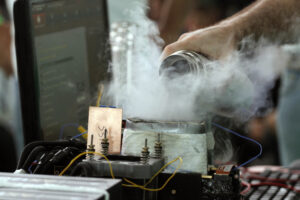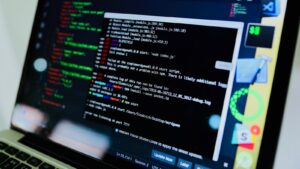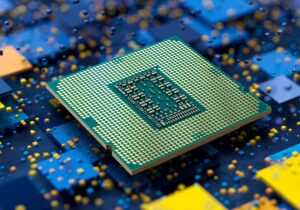Unlocking the true power of your hardware can be a breathtaking experience, much like uncovering hidden talents within oneself. In a world where technology is constantly evolving, tapping into the full potential of your devices becomes a challenge worth embracing. From lightning-fast processors to cutting-edge graphics cards, your hardware yearns to be mastered, eager to showcase its prowess. So, gear up, fellow tech enthusiasts, for an exhilarating journey into the realm of performance optimization techniques. In this article, we shall embark on a quest to unravel the untapped capabilities of your beloved machines, empowering you to witness unprecedented levels of speed, efficiency, and sheer computing magnificence. Get ready to seize the reins and take your hardware on a wild ride towards its limitless potential. Brace yourselves for an enlightening odyssey that will forever change the way you interact with technology. Welcome, ladies and gentlemen, to a world where the extraordinary becomes ordinary, and the power of your hardware reigns supreme.
Understanding the Basics: Maximizing Hardware Efficiency for Peak Performance
When it comes to squeezing every drop of performance out of your hardware, understanding the basics is crucial. By maximizing hardware efficiency, you can unlock the true potential of your devices and experience peak performance like never before. In this post, we will explore a range of performance optimization techniques that will empower you to unleash the full power of your hardware.
First and foremost, one of the key principles of hardware efficiency is ensuring proper cooling. Overheating can significantly hamper the performance of your hardware, causing it to slow down and even crash. To prevent this, make sure your devices are adequately ventilated and consider investing in cooling solutions such as fans or liquid cooling systems. Moreover, regularly cleaning your hardware from dust and debris will help maintain optimal temperatures within your devices.
Another effective way to maximize hardware efficiency is by optimizing your operating system and software. This can be achieved through various methods, including:
- Updating your operating system and software to the latest versions. These updates often include performance enhancements and bug fixes.
- Removing unnecessary startup programs that consume system resources.
- Disabling visual effects and animations, which can consume valuable processing power.
- Configuring power management settings to prioritize performance over energy saving.
By following these hardware optimization techniques, you can take your computing experience to new heights. Don’t settle for mediocre performance – unleash the full potential of your hardware and enjoy the speed and efficiency you deserve.
Fine-tuning your System: Optimizing Components for Enhanced Speed and Responsiveness
Are you tired of sluggish performance and delays on your system? Don’t worry; we’ve got you covered! In this post section, we will explore some performance optimization techniques that can unleash the full potential of your hardware, enhancing the speed and responsiveness of your system like never before.
Firstly, one of the key components to consider when fine-tuning your system is your processor. Upgrading to a faster and more powerful CPU can significantly boost your system’s performance. Look for processors with higher clock speeds and multiple cores, as they can handle tasks more efficiently. Additionally, consider overclocking your CPU, which involves increasing its clock speed, to extract even more power from it. Remember to exercise caution and consult the manufacturer’s guidelines to prevent any potential overheating issues.
Next, let’s talk about your memory, also known as RAM (Random Access Memory). Increasing the amount of RAM in your system can greatly improve its speed and responsiveness. With more RAM, your computer can store and access data faster, reducing lag and loading times. Upgrade your memory modules to higher capacities or opt for faster RAM speeds to keep up with demanding applications and multitasking. Utilize the benefits of dual-channel or quad-channel memory configurations, which can provide increased bandwidth and performance.
Lastly, optimizing your storage solution is crucial for improved system performance. Consider upgrading to a Solid-State Drive (SSD) instead of traditional Hard Disk Drives (HDD). SSDs offer faster read and write speeds, allowing your system to access data swiftly and launch applications in a blink of an eye. Another method to speed up your storage is defragmenting your hard drive, which rearranges fragmented files, ensuring faster data access. Finally, prioritize keeping your storage organized and decluttered. Regularly clean up unnecessary files and utilize disk cleanup tools to free up precious storage space.
By implementing these performance optimization techniques, you can unleash the full potential of your hardware, transforming your system into a powerful and responsive machine. Remember to carefully research and consider compatibility before making any upgrades, ensuring seamless integration of new components. Fine-tuning your system to achieve enhanced speed and responsiveness will undoubtedly elevate your user experience, making everyday tasks a breeze and unlocking the true capabilities of your hardware. So get ready to take your system to the next level and enjoy the ultimate performance optimization journey!
Efficient Cooling Strategies: Maintaining Ideal Temperatures for Optimal Hardware Functioning
Ensuring optimal temperatures for your hardware is crucial for maximizing performance and extending its lifespan. With efficient cooling strategies, you can unleash the full potential of your hardware and avoid issues like overheating that can lead to costly repairs or even permanent damage. In this post, we will explore some performance optimization techniques that will help you maintain ideal temperatures for optimal hardware functioning.
One of the key factors in efficient cooling is proper airflow management within your system. This can be achieved by strategically placing fans, optimizing cable management, and ensuring proper ventilation in your PC case. By directing the airflow effectively, you can prevent hot spots and maintain a consistent temperature throughout your hardware components. Make sure to clean your fans regularly as dust accumulation can hinder proper airflow and reduce cooling efficiency.
Another effective cooling strategy is to use a combination of active and passive cooling methods. Active cooling involves the use of fans or liquid cooling systems to dissipate heat from your hardware. On the other hand, passive cooling relies on heatsinks and thermal pads to transfer heat away from sensitive components. By utilizing both methods, you can create a balanced cooling solution that effectively manages heat while minimizing noise levels. Remember to choose high-quality cooling solutions that are compatible with your hardware for optimal results.
- Ensure proper airflow management in your system.
- Clean fans regularly to prevent dust accumulation.
- Utilize a combination of active and passive cooling methods.
- Choose high-quality cooling solutions compatible with your hardware.
By implementing these efficient cooling strategies, you can maintain ideal temperatures for optimal hardware functioning. Not only will this improve the overall performance of your system, but it will also provide a more stable and reliable experience. Take the necessary steps to maximize your hardware’s potential and enjoy smoother operations in all your computing endeavors.
Software Optimization Techniques: Streamlining Processes for Optimal Hardware Utilization
When it comes to maximizing the efficiency and performance of your software, harnessing the full power of your hardware is paramount. In today’s ever-evolving technological landscape, simply having cutting-edge hardware is not enough - you need to optimize your software to ensure that it seamlessly integrates with your hardware, allowing for optimal utilization.
One of the key techniques to achieve this is through parallel processing. By breaking down complex tasks into smaller, more manageable sub-tasks that can be executed simultaneously, you can fully exploit the capabilities of multi-core processors or distributed computing systems. This approach not only improves overall performance but also reduces processing time, making your software lightning-fast.
Another technique that can revolutionize your software’s optimization is memory management. Efficiently utilizing available memory resources can significantly enhance performance. By implementing techniques such as cache optimization, memory pooling, and memory compression, you can streamline your software’s memory usage, reducing unnecessary overhead and improving speed and responsiveness. These memory management techniques can be vital in resource-intensive applications such as gaming, data analysis, and artificial intelligence.
Extending Lifespan: Proactive Measures to Preserve and Improve Hardware Performance
In the fast-paced world of technology, staying proactive when it comes to extending the lifespan of your hardware is crucial. By implementing performance optimization techniques, you can unlock the full potential of your hardware and ensure it operates at peak efficiency for an extended period. In this post, we will explore some proactive measures you can take to preserve and improve your hardware’s performance, optimizing every aspect of its operation.
1. **Regular Hardware Maintenance:** Just like our bodies, hardware requires regular maintenance to stay in top shape. By physically cleaning your hardware components, you can remove dust and debris that may hinder performance. Additionally, checking for loose connections and tightening screws ensures that everything is securely in place. Regularly updating device drivers and firmware is equally important as it ensures compatibility with the latest software and maximizes performance potential.
2. **Optimizing Software and Settings:** Software optimization plays a crucial role in extending hardware lifespan. Uninstalling unnecessary programs and clearing temporary files helps declutter your system, freeing up valuable resources. Adjusting power settings to balance performance with energy efficiency can also have a significant impact on hardware longevity. Furthermore, configuring software applications to limit background processes and disabling unnecessary startup programs can help prevent system slowdowns and optimize overall performance.
3. **Effective Cooling Solutions:** Overheating is a significant factor that can degrade hardware performance and shorten its lifespan. Investing in quality cooling solutions such as fans or liquid cooling systems can efficiently dissipate heat and keep temperatures in check. Additionally, ensuring proper airflow within your system’s case and regularly cleaning cooling components prevent dust buildup, allowing for optimal cooling. Monitoring component temperatures through software and adjusting fan speeds accordingly can also help prevent overheating issues.
By adopting these proactive measures, you can effectively extend the lifespan of your hardware while unleashing its full potential. Regular maintenance, software optimization, and efficient cooling solutions are key factors in preserving and enhancing your hardware’s performance. Embracing these techniques will not only maximize your system’s uptime but also save you the hassle and expense of premature replacements. So why settle for anything less than peak performance when you have the tools to unlock your hardware’s full potential?
Final Thoughts
As we conclude this exploration into the realm of performance optimization techniques, we hope to have illuminated a path towards unlocking the true potential of your hardware. From the intricacies of parallel processing to the art of memory management, we have ventured into the depths of this technical landscape, discovering hidden treasures along the way.
In this journey, we have witnessed how skillfully harnessing the power within your hardware can transcend limitations and propel your work to new horizons. It is akin to unveiling the brilliance of a diamond, where each facet reflects the dedication and artistry poured into optimizing your system.
Just as an orchestra harmonizes its symphony, the fusion of hardware and software creates a masterpiece of supreme functionality. Through meticulous code optimization, smart resource allocation, and deftly balancing workloads, you can orchestrate a symphony of efficiency, unleashing a breathtaking performance that defies expectations.
It is a testament to the ingenuity of the human mind that we can unleash the latent capabilities tucked away within our hardware. By embracing the latest advancements, staying a step ahead of technological evolution, and continuously refining our techniques, we can forge a path towards unrivaled performance.
As we bid farewell, we urge you to continue exploring the world of performance optimization. Embrace the challenges as opportunities for growth, and delve further into the realms of parallelism, memory optimization, and algorithmic advancements. Let your curiosity guide you on this thrilling journey of discovery.
Remember, the full potential of your hardware lies within your grasp. Embrace the power at your fingertips, push the boundaries of what is deemed possible, and unlock a world of endless possibilities. Let your hardware sing the symphony it was destined to perform, and delight in the knowledge that you have harnessed its true potential.



